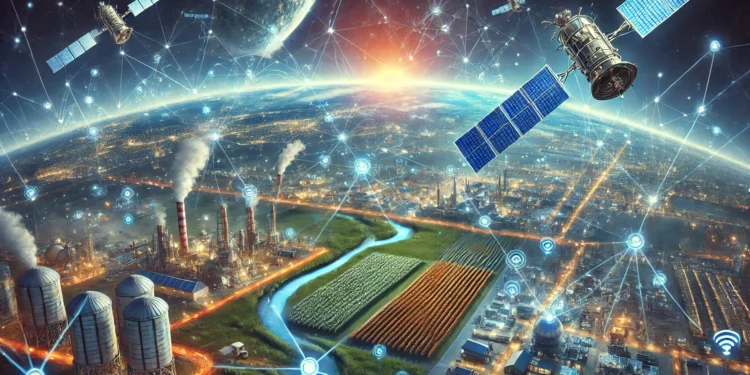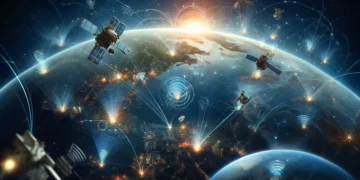Traditional wired and mobile communication networks often need help to operate in rural or desolate terrains. However, Satellite IoT solutions are now offered to address this need. These solutions provide a new, reliable, and scalable means for the integration of devices and systems in contemporary geography.
Whether a corporation needs to keep track of a wind turbine in the central part of the ocean, a logistics fleet across desert terrains, or manage precision farming equipment, Satellite IoT solutions are ideal for the spaces that traditional networks cannot reach.
Imagine the impact this satellite technology can have on the unsteady Industries worldwide!
What is meant by Satellite IoT Solutions?
Allow us to simplify:
Satellite IoT is a satellite industry hybrid with IoT satellite services.
As illustrated, these solutions allow uninterrupted connectivity between different devices regardless of their location.
Satellite IoT relies on satellite constellations in GEO, MEO, or LEO profiles instead of fixed terrestrial infrastructure like regular IoT networks.
How It Works:
- IoT devices are input/output devices that store information from sensors or other inputs.
- This information is sent to satellite-connected cars moving around the earth.
- The information is then transmitted to the core systems or clouds for processing and analysis when transmitted by satellites.
The result? Real-time insights and control over operations, even in the most remote corners of the planet.
Why Businesses Need Satellite IoT Solutions
1. Connectivity
Satellite IoT solutions ensure that companies stay connected with their operations without the option of terrestrial connectivity. With Satellite technology, you can run something as complex as an oil rig in the middle of the ocean, a mine in the middle of the desert, or a forest-based research center.
2. Cost-Effective
It is expensive and impractical to lay cell towers or fiber optic cables in secluded regions of a country. Satellite IoT does not require such investment. It is much more cost-efficient and can be scaled easily.
3. Real-Time Decision-Making
Satellite IoT provides information businesses can gather and act on from a single platform, giving them the needed efficiency. This is very useful, for instance, in the logistics sector, where accurate identification of the position of fleets and the best routes to take are essential.
4. Enhanced Security
Private satellite networks provide secure and independent IoT satellite communication, which is essential to industries where information security is important, including banking and other financial sectors as well as military and governmental organizations.
Industries Revolutionized by Satellite IoT
Agriculture
In smart farming, IoT sensors check the soil’s and climate conditions and the crop’s overall health, thus helping the farmer effectively use resources to yield more. Satellite IoT makes this possible even in rural areas where connectivity is rare.
Transportation and Logistics
Satellite IoT also helps the fleet manager track connected cars and cargo in real time, thus improving delivery times while removing operational bottlenecks. For vehicles on the road that are part of the internet, a satellite connection guarantees communication even on twisting roads.
Energy and Utilities
Whether it is following up pipelines and grids or handling distant renewable energy facilities such as wind power plants, Satellite IoT offers the right tools to boost security, minimize disturbances, and increase effectiveness.
Emergency Response and Disaster Recovery
In case of natural disasters or a network malfunction, IoT satellite communication is guaranteed with continuity, allowing for prompt response from rescue teams.
Maritime and Aviation
Satellite IoT is also essential to the maritime and aviation industries for navigation assistance, safety utilities, and operational tracking, even in the most remote areas of the world.
Key Features of Satellite IoT Solutions
1. Global Coverage
Satellite IoT is always on and can communicate from the sea or the middle of the desert, mountain, or other region. That is one reason industries with assets located far and wide would need it.
2. Low-Latency Communication
LEO satellite constellations have greatly improved through improved latency, which translates to a better solution for time-sensitive applications like self-driving cars or real-time asset tracking.
3. Scalability and Flexibility
Satellite IoT is quite flexible for businesses, meaning its networks can grow together with businesses. Such flexibility guarantees cost-effectiveness in the long run and serves the client’s needs in the future.
4. Integration with Emerging Technologies
Satellite IoT is fully compatible with others like 5G and AI, creating the foundations for intelligent systems and device intermediaries to function cohesively across geographic locations.
Benefits of Satellite IoT for Businesses
1. Enhanced Productivity
There are several advantages of automating processes and remote monitoring, which help solve problems of excessive downtime.
2. Sustainability Goals
Satellite IoT enables more resource optimization, supporting business sustainability across agriculture, energy, and logistics industries.
3. Business Resilience
Satellite IoT offers business resilience irrespective of network breakdowns, meteorological calamities, or political instabilities in specific geographical locations.
4. Cost Savings
Firstly, it eliminates the need for expensive terrestrial infrastructure, decreasing capital costs; second, real-time information guarantees lower operational expenses.
Technological Innovations in Satellite IoT
1. Electronically Steerable Antennas
Affordable and lightweight devices that can switch between GEO and LEO satellites are revolutionizing satellite IoT installation. Such solutions are easy to implement, work with high efficiency, and are appropriate in mobile situations, such as cars or on unstable ground.
2. Advanced Network Management Systems (NMS)
Current advancements in technology also allow the complete control, management, and monitoring of satellite IoT networks using cloud-based platforms. These platforms incorporate tools for reporting, billing, inventory, and even advanced predictive maintenance for an overall solution for managing global environments.
3. Low-Power Devices
Many IoT devices used in satellite communication are low-power devices, so they can be deployed for a long duration in the field without maintenance.
The Future of Satellite IoT
- Satellite IoT is the answer to contemporary problems and the groundwork for tomorrow’s advancements. However, as LEO satellite constellations grow in the future, the latency should be even lower and the accessibility even more extensive. Here are a few trends shaping the future of Satellite IoT:
- Increased Industry Collaboration: Marketing partnerships between satellite providers and businesses will result in solutions that are more suited to particular operational issues.
- Private Satellite Networks: Dedicated networks will improve security and quality in organizations dealing with sensitive data.
- AI Integration: Satellite IoT systems backed by AI will make more intelligent automation, predictive maintenance, and advanced analytics more widespread.
Achieving More with Satellite IoT
From improving agriculture practices to disrupting supply chains around the world, Satellite IoT enhances business efficiency and optimizes resources. It fills the connectivity void as industries continue to revolutionize and become more competitive in a world where data dominates.
Through this technology, productivity gets a boost, sustainability is promoted, and businesses become ready to be leaders in the world economy in the future.
This technology goes far beyond people just being connected. It opens the door to effectiveness, creativity, and unprecedented organizational improvement.













